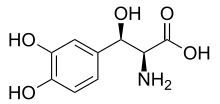Droxidopa
Droxidopa (INN; trade name Northera; also known as L-DOPS, L-threo-dihydroxyphenylserine, L-threo-DOPS and SM-5688) is a synthetic amino acid precursor which acts as a prodrug to the neurotransmitter norepinephrine (noradrenaline).[1] Unlike norepinephrine, droxidopa is capable of crossing the protective blood–brain barrier (BBB).[1]
 | |
| Clinical data | |
|---|---|
| Trade names | Northera |
| Other names | β,3-Dihydroxytyrosine |
| Routes of administration | Oral |
| ATC code | |
| Legal status | |
| Legal status |
|
| Pharmacokinetic data | |
| Bioavailability | 90% |
| Metabolism | Hepatic |
| Elimination half-life | 1.5 hours |
| Excretion | Renal |
| Identifiers | |
| |
| CAS Number | |
| PubChem CID | |
| ChemSpider | |
| UNII | |
| ChEBI | |
| ChEMBL | |
| CompTox Dashboard (EPA) | |
| ECHA InfoCard | 100.215.254 |
| Chemical and physical data | |
| Formula | C9H11NO5 |
| Molar mass | 213.189 g·mol−1 |
| 3D model (JSmol) | |
| |
| |
| (verify) | |
Indications
- Neurogenic orthostatic hypotension (NOH) dopamine beta hydrolase deficiency,[2] as well as NOH associated with multiple system atrophy (MSA), familial amyloid polyneuropathy (FAP), pure autonomic failure (PAF).
- Intradialytic hypotension (IDH) or hemodialysis-induced hypotension.
- Freezing of gait in Parkinson's disease (off-label)
History
Droxidopa was developed by Sumitomo Pharmaceuticals for the treatment of hypotension, including NOH,[2] and NOH associated with various disorders such as MSA, FAP, and PD, as well as IDH. The drug has been used in Japan and some surrounding Asian areas for these indications since 1989. Following a merger with Dainippon Pharmaceuticals in 2006, Dainippon Sumitomo Pharma licensed droxidopa to Chelsea Therapeutics to develop and market it worldwide except in Japan, Korea, China, and Taiwan. In February 2014, the Food and Drug Administration approved droxidopa for the treatment of symptomatic neurogenic orthostatic hypotension.[3]
Clinical trials
A systematic review and meta-analysis conducted on clinical trials comparing the clinical use of droxidopa and midodrine have found that midodrine was more likely to cause supine hypertension than droxidopa in patients with NOH. Midodrine was also found to be slightly more effective at raising blood pressure but not statistically significantly so.[4]
Chelsea Therapeutics obtained orphan drug status (ODS) for droxidopa in the US for NOH, and that of which associated with PD, PAF, and MSA. In 2014, Chelsea Therapeutics was acquired by Lundbeck along with the rights to droxidopa which was launched in the US in Sept 2014.[5]
Pharmacology
Droxidopa is a prodrug of norepinephrine used to increase the concentrations of these neurotransmitters in the body and brain.[1] It is metabolized by aromatic L-amino acid decarboxylase (AAAD), also known as DOPA decarboxylase (DDC). Patients with NOH have depleted levels of norepinephrine which leads to decreased blood pressure or hypotension upon orthostatic challenge.[6] Droxidopa works by increasing the levels of norepinephrine in the peripheral nervous system (PNS), thus enabling the body to maintain blood flow upon and while standing.
Droxidopa can also cross the blood–brain barrier (BBB) where it is converted to norepinephrine from within the brain.[1] Increased levels of norepinephrine in the central nervous system (CNS) may be beneficial to patients in a wide range of indications. Droxidopa can be coupled with a peripheral aromatic L-amino acid decarboxylase inhibitor (AAADI) or DOPA decarboxylase inhibitor (DDC) such as carbidopa (Lodosyn) to increase central norepinephrine concentrations while minimizing increases of peripheral levels.
Side effects
With over 20 years on the market, droxidopa has proven to have few side effects of which most are mild. The most common side effects reported in clinical trials include headache, dizziness, nausea, hypertension and fatigue.[7][8][9]
References
- Goldstein DS (2006). "L-Dihydroxyphenylserine (L-DOPS): a norepinephrine prodrug". Cardiovascular Drug Reviews. 24 (3–4): 189–203. doi:10.1111/j.1527-3466.2006.00189.x. PMID 17214596.
- Mathias CJ (March 2008). "L-dihydroxyphenylserine (Droxidopa) in the treatment of orthostatic hypotension: the European experience". Clinical Autonomic Research. 18 Suppl 1 (Supplement 1): 25–9. doi:10.1007/s10286-007-1005-z. PMID 18368304.
- "FDA grants accelerated approval to NORTHERA (droxidopa) for patients with symptomatic NOH". news-medical.net. February 18, 2014.
- Chen JJ, Han Y, Tang J, Portillo I, Hauser RA, Dashtipour K (December 2018). "Standing and Supine Blood Pressure Outcomes Associated With Droxidopa and Midodrine in Patients With Neurogenic Orthostatic Hypotension: A Bayesian Meta-analysis and Mixed Treatment Comparison of Randomized Trials". The Annals of Pharmacotherapy. 52 (12): 1182–1194. doi:10.1177/1060028018786954. PMID 29972032.
- "Lundbeck Announces Availability of NORTHERATM (droxidopa) Capsules in the U.S. for Symptomatic Neurogenic Orthostatic Hypotension" (PDF). Lundbeck NA Ltd.
- Robertson D (March 2008). "The pathophysiology and diagnosis of orthostatic hypotension". Clinical Autonomic Research. 18 Suppl 1 (Supplement 1): 2–7. doi:10.1007/s10286-007-1004-0. PMID 18368300.
- Kaufmann H, Freeman R, Biaggioni I, Low P, Pedder S, Hewitt LA, et al. (July 2014). "Droxidopa for neurogenic orthostatic hypotension: a randomized, placebo-controlled, phase 3 trial". Neurology. 83 (4): 328–35. doi:10.1212/WNL.0000000000000615. PMC 4115605. PMID 24944260.
- Hauser RA, Isaacson S, Lisk JP, Hewitt LA, Rowse G (April 2015). "Droxidopa for the short-term treatment of symptomatic neurogenic orthostatic hypotension in Parkinson's disease (nOH306B)". Movement Disorders. 30 (5): 646–54. doi:10.1002/mds.26086. PMID 25487613.
- "Highlights of prescribing information for Northeratm (droxidopa)" (PDF). Chelsea Therapeutics, Inc. 2014.